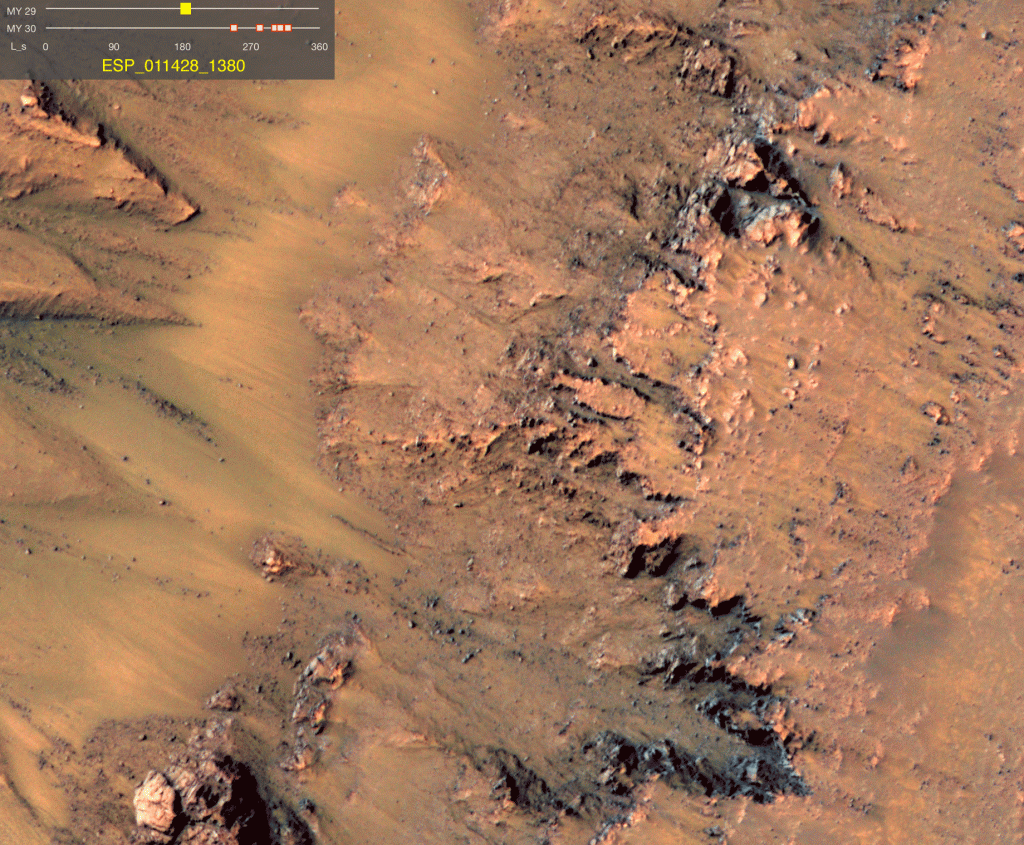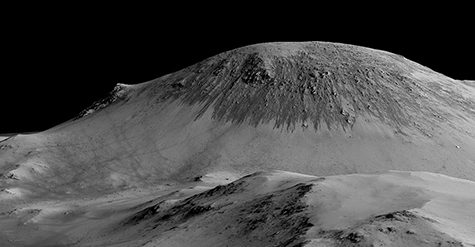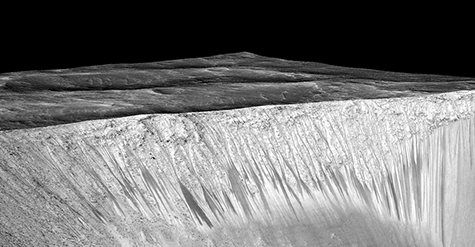
With news that there is liquid water on Mars, Raymond E. Arvidson, PhD, the James S. McDonnell Distinguished University Professor in earth and planetary sciences in Arts & Sciences at Washington University in St. Louis and resident expert on Mars, explains how this discovery is different from earlier hints and signs of water on the red planet; whether we’re likely to find life now that we have found water; and whether the Opportunity rover will go explore the watery sites.
What’s different?
“It’s really a tale of two instruments,” Arvidson said of the report this week that briny water still flows on Mars.
Five years ago, the team in charge of HiRISE, a camera aboard the Mars Reconnaissance Orbiter, published a paper in Science about strange dark streaks that appeared along the slopes of craters and mountains on Mars. The streaks lengthened during the summer and faded during the winter, only to reappear the following spring.
“How they formed was a mystery,” Arvidson said. “Was it a dry process, where material detached from the upper slope and rolled downhill, or was there in some way, shape or form a fluid lubricating the process? You see streaks like these in the Southwestern U.S., but they’re typically associated with water.”

The streaks looked like seeping water, but the scientists, being scientists, carefully called them “recurring slope lineae,” or RSL, a term that was strictly descriptive and made no claims.
What they needed to make a case was a read on the chemistry of the streaks, but there they faced a technical problem. The Mars Reconnaissance Orbiter also carries an instrument used for chemical analysis, the CRISM spectrometer, but its focus is not as sharp as HiRISE’s.
A HiRISE pixel covers 25 centimeters on the surface, but in CRISM’s normal mode the pixel size on the surface is 18 meters, said Arvidson, who is on the science team for CRISM.
Unfortunately, the biggest streaks are only a few meters wide, so it wasn’t possible for CRISM to sample them — and only them — in this mode.
“But together with the Applied Physics Laboratory, we developed a way of gimballing the optics on the instrument so that it could take overlapping measurements in the along-track direction. You look at a whole bunch of pixels; each is 18 meters but they overlap, and that allows you to process the data to get higher resolution.
Operating in this new mode, they found diagnostic signs of liquid water and hydrated salts at four locations on Mars. The salts were all perchlorates, compounds that include a ClO4– group.
“The perchlorate dissolves in water and when it evaporates, it leaves behind a perchlorate salt with water in its lattice; this is the water CRISM saw,” said Arvidson.
“The perchlorate is important because it lowers the freezing point of water — by as much as 70 degrees, depending on the salt. So it’s not like you have big gushers of pure water coming out. It’s more like a briny goo, but it is enough to lubricate the breakout at the tops of cliffs and to set things running downhill.”
Follow the water?
No sooner did NASA say water than reporters started calling up astrobiologists to see whether they thought finding water meant there is life on Mars. Some did and some didn’t. Arvidson commented wryly to USA Today, “I wouldn’t want to live in perchlorate.”
Percholate, he explained, also forms naturally in very arid environments on Earth, but it is a strong oxidizer, which is why it is used as one component of rocket fuel and why it is toxic to us.

However, he said there is a group of microbes on Earth that grow by reducing perchlorate. This is one of only a handful of biological processes to generate oxygen besides photosynthesis.
But, he said, we can’t just drive the rover over and scoop up some of the streak soil. There’s a planetary protection issue. We don’t want to introduce organisms that might start living in the brine.
The streaked areas are now “special regions,” a NASA term for regions where there may be life. “So visiting them requires a whole lot more sterilization and a whole lot more thought than touring the ancient rocks of Mars that Opportunity and Curiosity are now exploring,” Arvidson said. Neither rover was baked to sufficiently high temperatures before launch to qualify as superclean.
“So visiting the streaks is an exciting prospect, but the question is going to be how do we do it without contaminating them or disturbing whatever life might be there.”